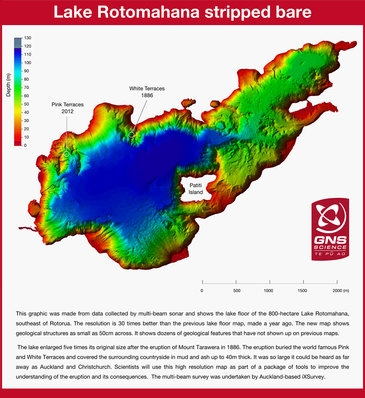Substantial portion of Pink Terraces survived eruption
Remapping the topography of the lake floor with sonar equipment previously provided scientists with a high resolution map. However, as technological developments continue to advance, new methods of measurement come along to provide even greater detail.
Previous sonar mapping revealed a number of features lying hidden on the lake floor as a result of the 1886 eruption of Mount Tarawera. The data showed a number of volcanic craters as well as the deep rift that formed when the lake floor unzipped violently, dramatically and permanently.
Sonar Vs Seismic
Sonar provided an excellent view of the topography of the lake floor, however to delve deeper and gain greater clarity, scientists involved in further research of the lake, harnessed the power of seismic equipment, to deliver data of great detail that opened up the lake floor in ways never previously achieved.
Seismic equipment works on acoustic vibration that reflects off geological layers within the lake and it was the seismic readings from this equipment that corroborated findings that a substantial portion of the Pink Terraces appears to have survived the 1886 eruption of Mount Tarawera - covered of course by meters of sediment.
Low-frequency seismic equipment mapped the top layer of the lake and a higher frequency surveyed over areas of particular interest. This is done because higher frequency seismic penetrates less and shows greater detail, revealing underlying rock layers – the hard pre-existing matter that they were looking for.
Project leader Dr De Ronde is quoted as saying “The seismic data has enabled us to strip off about 40 meters of sediment on the lake floor and see the hard post-eruption surface of the lake and other geological structures at depth.”
Of significant discovery was the indication of hard surfaces at the same depth and in the same location that the Pink Terraces would be, this is in part backed up by the previous years mapping which indicated the same area as that of the Pink Terraces.
As explained by the man himself, Dr De Ronde:
“Last year we found the two bottom tiers of the buttress adjacent to main staircase of the Pink Terraces. This year the seismic data is telling us that there is a 40-meter-wide and three-storey-high stack of very hard material exactly where we estimate the Pink Terraces should be”.
“We believe this represents a substantial portion of the Pink Terraces, although we were not able to determine their state of preservation. We were unable to image the individual terraces, the cascading and scalloped shapes of the Pink Terraces proved challenging to image as the seismic signals were scattered by the many hard surfaces at different angles.”
Despite this challenge, the large amount of data collected during the survey has unearthed new revelations and begs for continued studies of the Tarawera Lake and the active geothermal systems underneath it.
As scientific capabilities continue to increase, the anticipation of what is yet to be revealed and understood will no doubt fuel the next in-depth project.









Connect with Us
Facebook YouTube Instagram Tripadvisor Blog Email